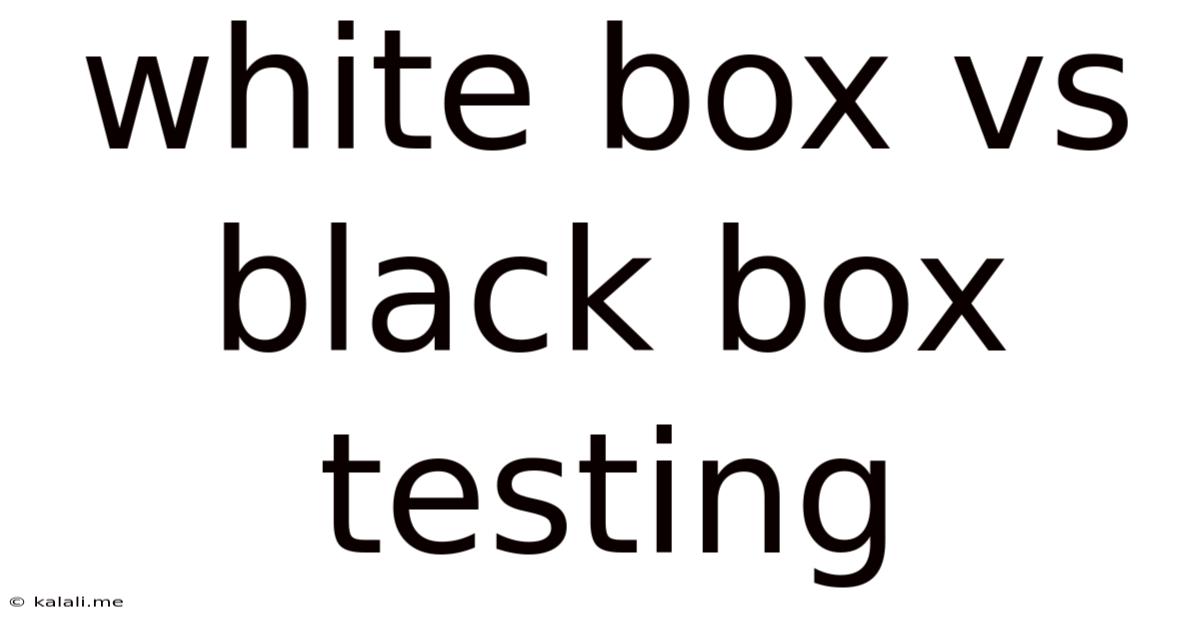White Box Vs Black Box Testing
Kalali
Jun 09, 2025 · 4 min read

Table of Contents
White Box vs. Black Box Testing: A Comprehensive Guide
Choosing the right testing method is crucial for ensuring software quality. This article delves into the core differences between white box testing and black box testing, explaining their strengths, weaknesses, and when to use each approach. Understanding these methodologies is essential for any software development team striving for robust and reliable applications.
White box testing and black box testing represent two fundamental approaches to software testing. While both aim to identify defects, they differ significantly in their methods and the level of internal knowledge required.
What is White Box Testing?
White box testing, also known as transparent box testing, open box testing, or clear box testing, is a software testing method where the internal structure/design/code of the item being tested is known to the tester. Testers have access to the source code, internal databases, and other internal information. This allows for a thorough examination of the program's logic, paths, and internal workings. The goal is to identify flaws and vulnerabilities within the code itself, ensuring that each component functions correctly.
Key Characteristics of White Box Testing:
- Requires programming knowledge: Testers need a strong understanding of programming languages and the application's architecture.
- Focus on code structure: Tests are designed to cover various code paths, branches, and statements.
- High test coverage: It allows for exhaustive testing, covering even the most intricate parts of the code.
- Early bug detection: Issues can be detected early in the development lifecycle, reducing costs and time spent on fixing later-stage defects.
- Techniques used: Include statement coverage, branch coverage, path coverage, and condition coverage.
What is Black Box Testing?
Black box testing is a software testing method where the internal structure/design/code of the item being tested is not known to the tester. Testers treat the software as a "black box," focusing solely on its inputs and outputs. This approach is independent of the internal workings of the application. The objective is to verify that the software meets its specified requirements and functions correctly from the user's perspective.
Key Characteristics of Black Box Testing:
- No programming knowledge required: Testers don't need to know the internal code; they focus on functionality.
- Focus on functionality and requirements: Tests are based on the software's specifications and user requirements.
- Real-world scenarios: Tests often simulate real-world user scenarios to ensure usability and functionality.
- Unbiased testing: Testers are less likely to be influenced by their knowledge of the internal code, leading to more objective results.
- Techniques used: Include equivalence partitioning, boundary value analysis, decision table testing, state transition testing, and user acceptance testing (UAT).
White Box vs. Black Box Testing: A Comparison Table
| Feature | White Box Testing | Black Box Testing |
|---|---|---|
| Knowledge of Internal Structure | Known | Unknown |
| Tester Skillset | Requires programming knowledge | Does not require programming knowledge |
| Testing Focus | Code structure, logic, and internal workings | Functionality, requirements, and user experience |
| Test Design | Based on internal code structure | Based on specifications and user requirements |
| Test Coverage | High, potentially exhaustive | Moderate to High, depends on testing strategy |
| Bug Detection | Early in the development cycle | Later in the development cycle |
| Examples | Unit testing, integration testing | System testing, acceptance testing, user acceptance testing |
When to Use Which Method?
The choice between white box and black box testing often depends on the specific context and project needs.
-
Use White Box Testing when:
- You need high test coverage and early bug detection.
- You have experienced programmers who can perform the testing.
- Security testing is crucial.
- You need to test specific code paths and internal functionalities.
-
Use Black Box Testing when:
- You want to test the system from a user's perspective.
- You lack access to the internal code.
- You need to verify that the software meets its requirements.
- You want to perform user acceptance testing (UAT).
Conclusion
Both white box and black box testing play critical roles in ensuring software quality. Ideally, a comprehensive testing strategy incorporates both approaches, leveraging their individual strengths to identify a wider range of defects and improve the overall reliability of the software. By understanding the differences and applying the appropriate methods, development teams can significantly enhance the quality and success of their software projects.
Latest Posts
Latest Posts
-
What Is 3 X 3 X 3
Jul 01, 2025
-
How Many Apples In A 3 Pound Bag
Jul 01, 2025
-
How Many Pounds Is A Bushel Of Peanuts
Jul 01, 2025
-
How Many Pounds Are In 32 Ounces
Jul 01, 2025
-
What Year Would I Be Born If I Was 21
Jul 01, 2025
Related Post
Thank you for visiting our website which covers about White Box Vs Black Box Testing . We hope the information provided has been useful to you. Feel free to contact us if you have any questions or need further assistance. See you next time and don't miss to bookmark.